ECU SAAB 9-3 2008 Owner's Guide
[x] Cancel search | Manufacturer: SAAB, Model Year: 2008, Model line: 9-3, Model: SAAB 9-3 2008Pages: 320, PDF Size: 56.39 MB
Page 141 of 320
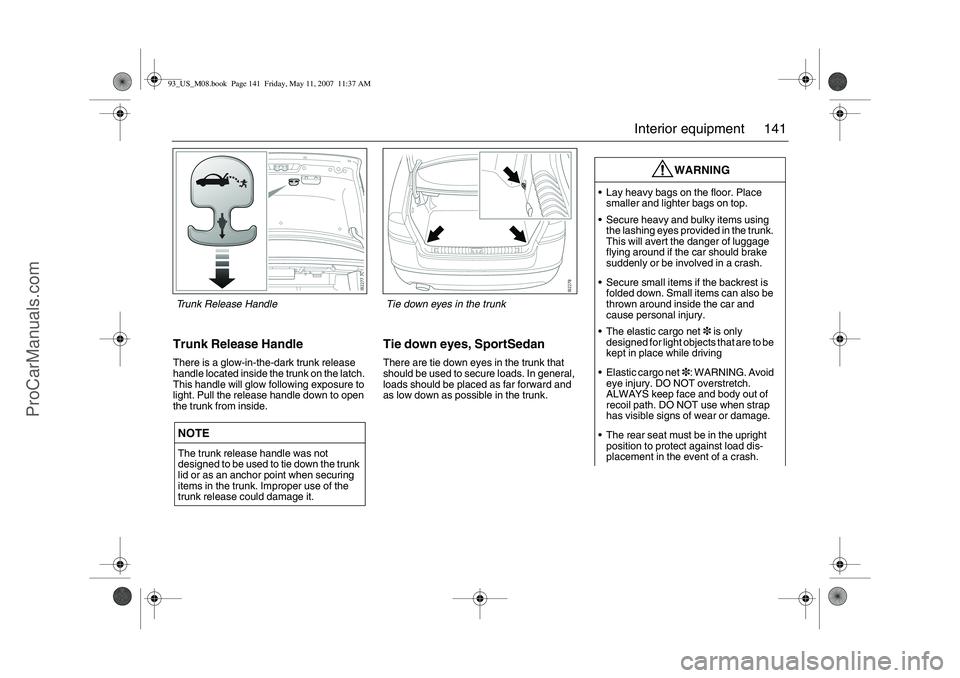
141 Interior equipment
Trunk Release HandleThere is a glow-in-the-dark trunk release
handle located inside the trunk on the latch.
This handle will glow following exposure to
light. Pull the release handle down to open
the trunk from inside.
Tie down eyes, SportSedanThere are tie down eyes in the trunk that
should be used to secure loads. In general,
loads should be placed as far forward and
as low down as possible in the trunk.
NOTEThe trunk release handle was not
designed to be used to tie down the trunk
lid or as an anchor point when securing
items in the trunk. Improper use of the
trunk release could damage it.
WARNING
Lay heavy bags on the floor. Place
smaller and lighter bags on top.
Secure heavy and bulky items using
the lashing eyes provided in the trunk.
This will avert the danger of luggage
flying around if the car should brake
suddenly or be involved in a crash.
Secure small items if the backrest is
folded down. Small items can also be
thrown around inside the car and
cause personal injury.
The elastic cargo net3 is only
designed for light objects that are to be
kept in place while driving
Elastic cargo net3: WARNING. Avoid
eye injury. DO NOT overstretch.
ALWAYS keep face and body out of
recoil path. DO NOT use when strap
has visible signs of wear or damage.
The rear seat must be in the upright
position to protect against load dis-
placement in the event of a crash.
Tie down eyes in the trunk
Trunk Release Handle93_US_M08.book Page 141 Friday, May 11, 2007 11:37 AM
ProCarManuals.com
Page 144 of 320
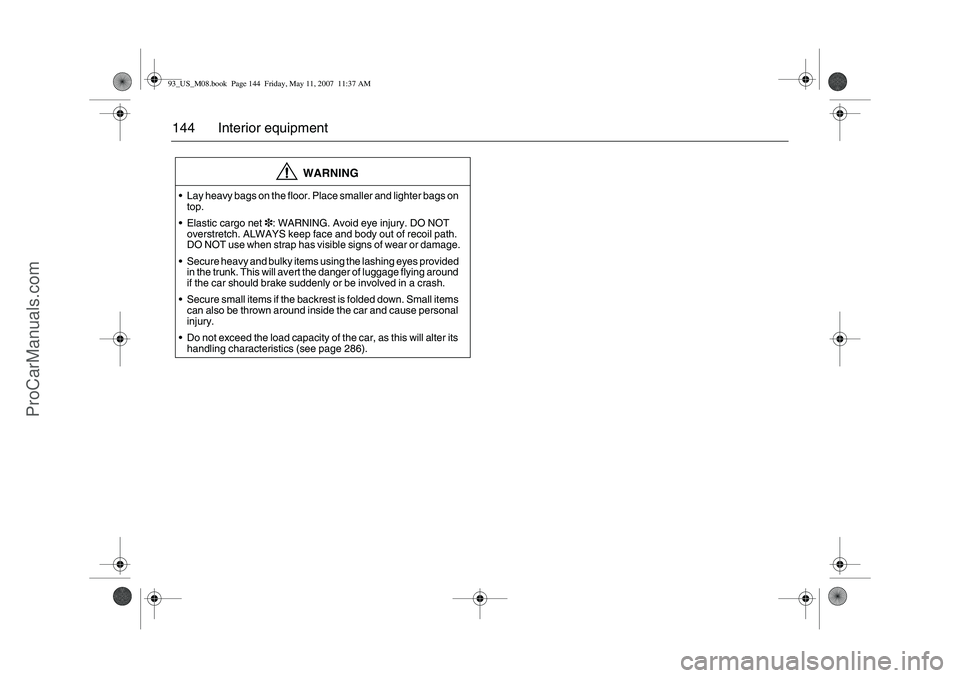
144 Interior equipment
WARNING
Lay heavy bags on the floor. Place smaller and lighter bags on
top.
Elastic cargo net3: WARNING. Avoid eye injury. DO NOT
overstretch. ALWAYS keep face and body out of recoil path.
DO NOT use when strap has visible signs of wear or damage.
Secure heavy and bulky items using the lashing eyes provided
in the trunk. This will avert the danger of luggage flying around
if the car should brake suddenly or be involved in a crash.
Secure small items if the backrest is folded down. Small items
can also be thrown around inside the car and cause personal
injury.
Do not exceed the load capacity of the car, as this will alter its
handling characteristics (see page 286).93_US_M08.book Page 144 Friday, May 11, 2007 11:37 AM
ProCarManuals.com
Page 145 of 320
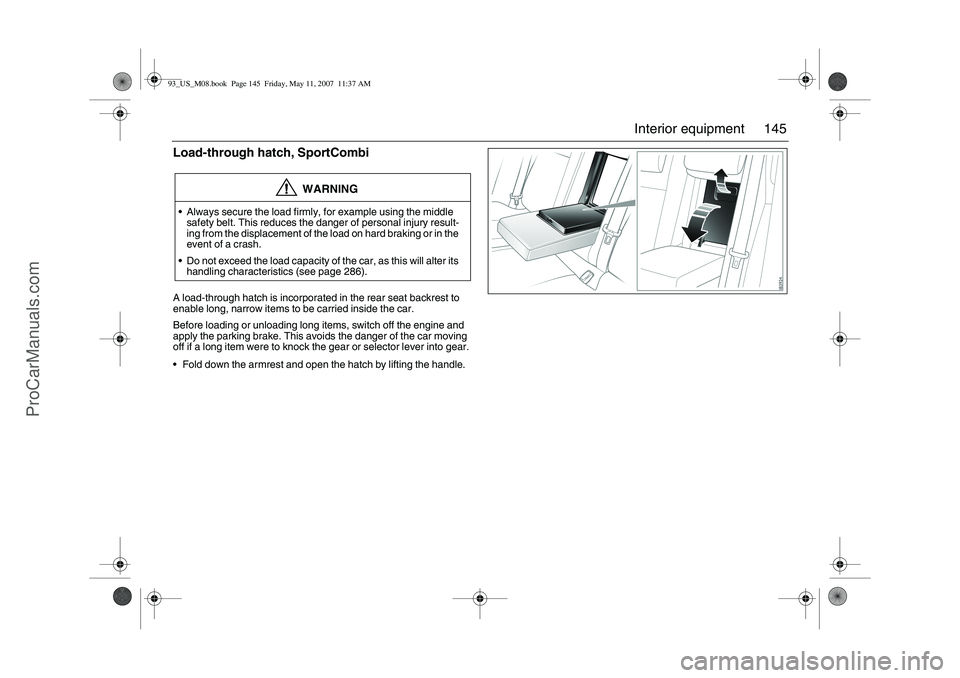
145 Interior equipment
Load-through hatch, SportCombiA load-through hatch is incorporated in the rear seat backrest to
enable long, narrow items to be carried inside the car.
Before loading or unloading long items, switch off the engine and
apply the parking brake. This avoids the danger of the car moving
off if a long item were to knock the gear or selector lever into gear.
Fold down the armrest and open the hatch by lifting the handle.
WARNING
Always secure the load firmly, for example using the middle
safety belt. This reduces the danger of personal injury result-
ing from the displacement of the load on hard braking or in the
event of a crash.
Do not exceed the load capacity of the car, as this will alter its
handling characteristics (see page 286).93_US_M08.book Page 145 Friday, May 11, 2007 11:37 AM
ProCarManuals.com
Page 146 of 320
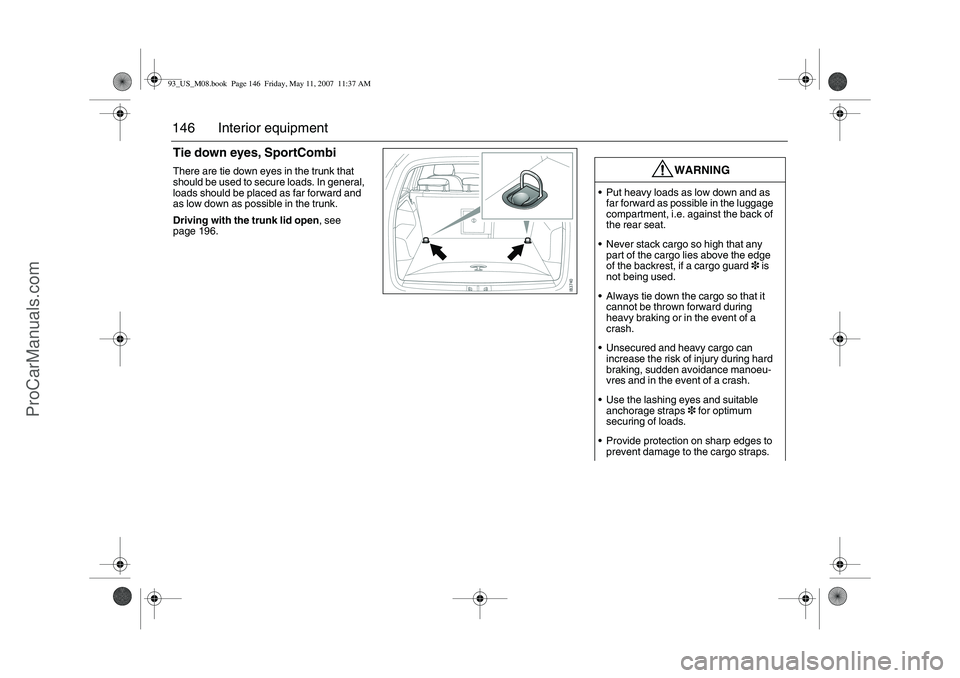
146 Interior equipmentTie down eyes, SportCombiThere are tie down eyes in the trunk that
should be used to secure loads. In general,
loads should be placed as far forward and
as low down as possible in the trunk.
Driving with the trunk lid open, see
page 196.
WARNING
Put heavy loads as low down and as
far forward as possible in the luggage
compartment, i.e. against the back of
the rear seat.
Never stack cargo so high that any
part of the cargo lies above the edge
of the backrest, if a cargo guard3 is
not being used.
Always tie down the cargo so that it
cannot be thrown forward during
heavy braking or in the event of a
crash.
Unsecured and heavy cargo can
increase the risk of injury during hard
braking, sudden avoidance manoeu-
vres and in the event of a crash.
Use the lashing eyes and suitable
anchorage straps3 for optimum
securing of loads.
Provide protection on sharp edges to
prevent damage to the cargo straps.
93_US_M08.book Page 146 Friday, May 11, 2007 11:37 AM
ProCarManuals.com
Page 147 of 320
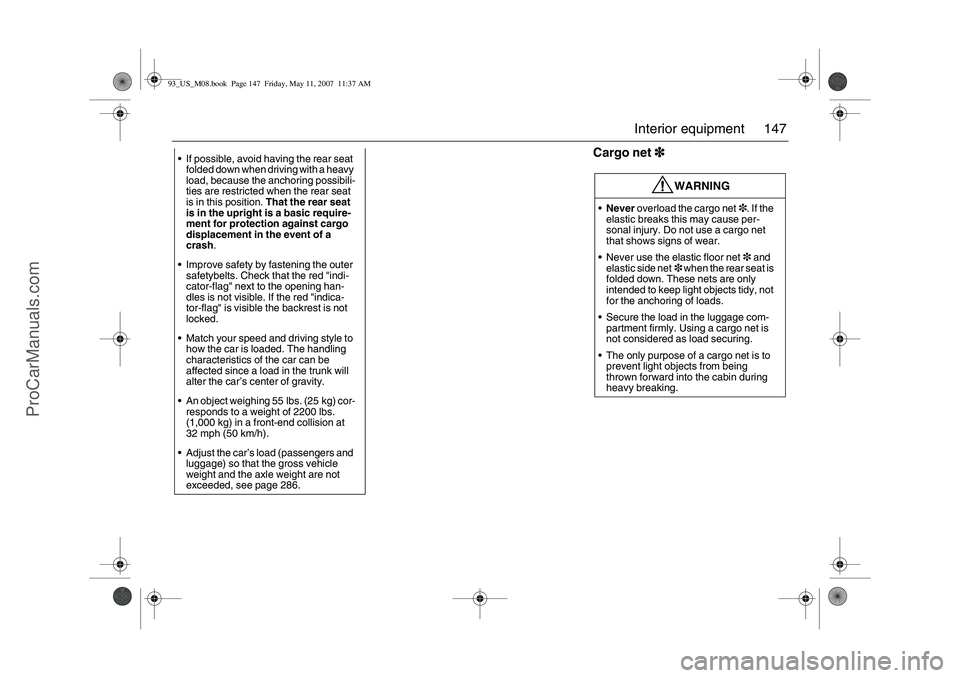
147 Interior equipment
Cargo net3
33 3
If possible, avoid having the rear seat
folded down when driving with a heavy
load, because the anchoring possibili-
ties are restricted when the rear seat
is in this position. That the rear seat
is in the upright is a basic require-
ment for protection against cargo
displacement in the event of a
crash.
Improve safety by fastening the outer
safetybelts. Check that the red "indi-
cator-flag" next to the opening han-
dles is not visible. If the red "indica-
tor-flag" is visible the backrest is not
locked.
Match your speed and driving style to
how the car is loaded. The handling
characteristics of the car can be
affected since a load in the trunk will
alter the car’s center of gravity.
An object weighing 55 lbs. (25 kg) cor-
responds to a weight of 2200 lbs.
(1,000 kg) in a front-end collision at
32 mph (50 km/h).
Adjust the car’s load (passengers and
luggage) so that the gross vehicle
weight and the axle weight are not
exceeded, see page 286.
WARNING
Never overload the cargo net3. If the
elastic breaks this may cause per-
sonal injury. Do not use a cargo net
that shows signs of wear.
Never use the elastic floor net3 and
elastic side net3 when the rear seat is
folded down. These nets are only
intended to keep light objects tidy, not
for the anchoring of loads.
Secure the load in the luggage com-
partment firmly. Using a cargo net is
not considered as load securing.
The only purpose of a cargo net is to
prevent light objects from being
thrown forward into the cabin during
heavy breaking.
93_US_M08.book Page 147 Friday, May 11, 2007 11:37 AM
ProCarManuals.com
Page 148 of 320
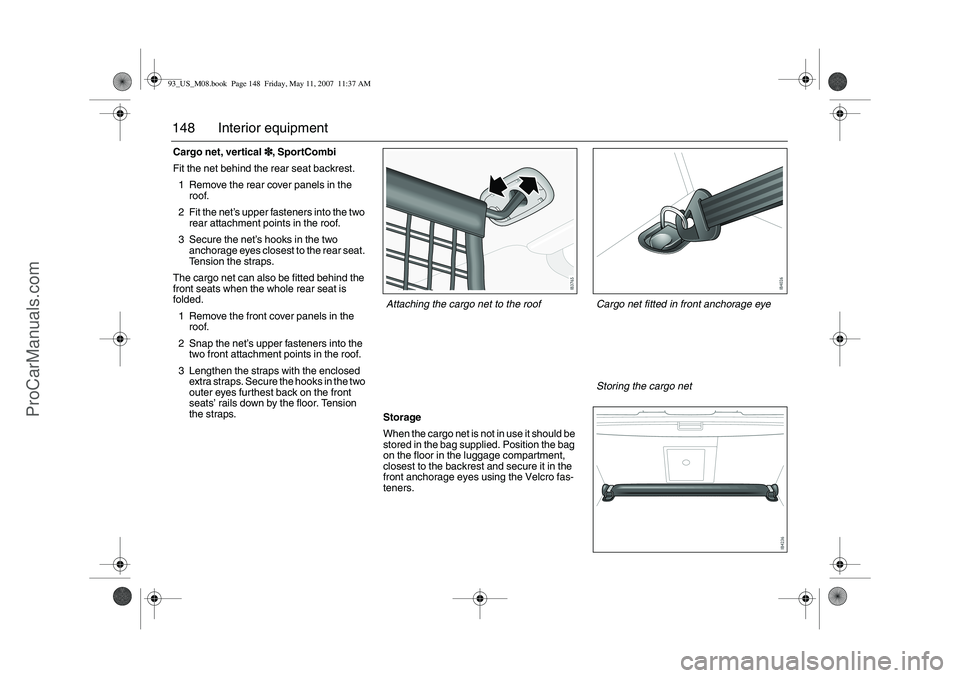
148 Interior equipmentCargo net, vertical3
33 3, SportCombi
Fit the net behind the rear seat backrest.
1 Remove the rear cover panels in the
roof.
2 Fit the net’s upper fasteners into the two
rear attachment points in the roof.
3 Secure the net’s hooks in the two
anchorage eyes closest to the rear seat.
Tension the straps.
The cargo net can also be fitted behind the
front seats when the whole rear seat is
folded.
1 Remove the front cover panels in the
roof.
2 Snap the net’s upper fasteners into the
two front attachment points in the roof.
3 Lengthen the straps with the enclosed
extra straps. Secure the hooks in the two
outer eyes furthest back on the front
seats’ rails down by the floor. Tension
the straps.
Storage
When the cargo net is not in use it should be
stored in the bag supplied. Position the bag
on the floor in the luggage compartment,
closest to the backrest and secure it in the
front anchorage eyes using the Velcro fas-
teners.
Attaching the cargo net to the roof
Cargo net fitted in front anchorage eyeStoring the cargo net
93_US_M08.book Page 148 Friday, May 11, 2007 11:37 AM
ProCarManuals.com
Page 149 of 320
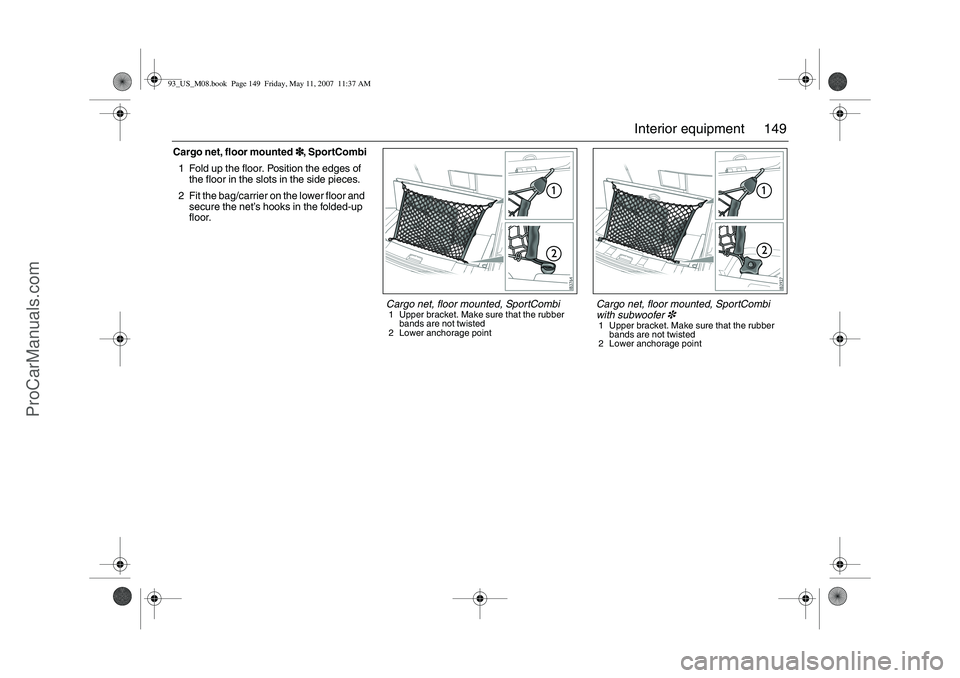
149 Interior equipment
Cargo net, floor mounted3
33 3, SportCombi
1 Fold up the floor. Position the edges of
the floor in the slots in the side pieces.
2 Fit the bag/carrier on the lower floor and
secure the net’s hooks in the folded-up
floor.
Cargo net, floor mounted, SportCombi1 Upper bracket. Make sure that the rubber
bands are not twisted
2 Lower anchorage point
Cargo net, floor mounted, SportCombi
with subwoofer
3
1 Upper bracket. Make sure that the rubber
bands are not twisted
2 Lower anchorage point
93_US_M08.book Page 149 Friday, May 11, 2007 11:37 AM
ProCarManuals.com
Page 166 of 320
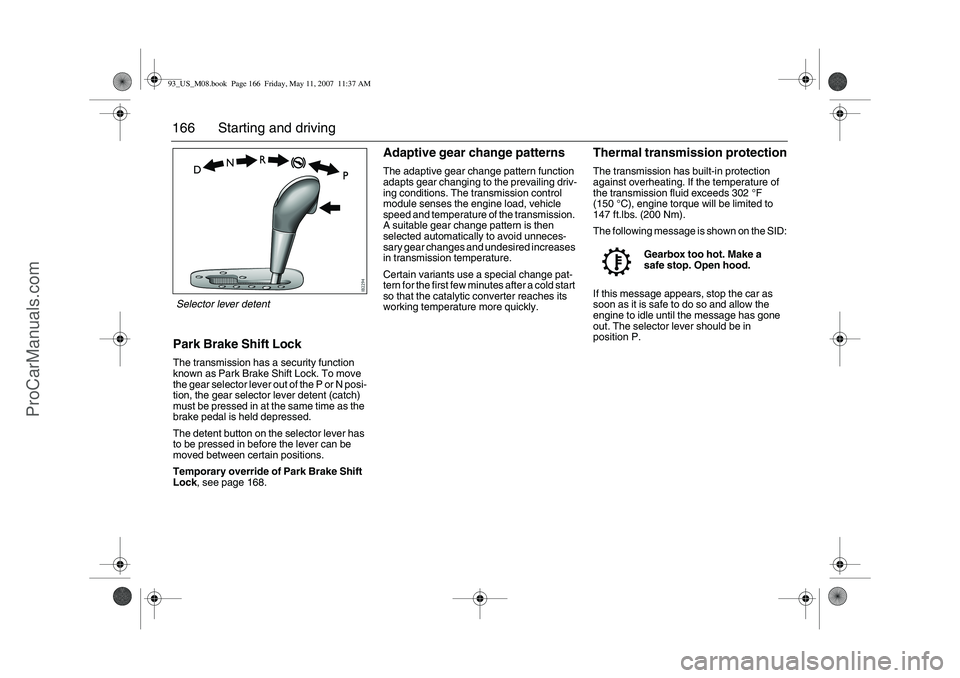
166 Starting and drivingPark Brake Shift LockThe transmission has a security function
known as Park Brake Shift Lock. To move
the gear selector lever out of the P or N posi-
tion, the gear selector lever detent (catch)
must be pressed in at the same time as the
brake pedal is held depressed.
The detent button on the selector lever has
to be pressed in before the lever can be
moved between certain positions.
Temporary override of Park Brake Shift
Lock, see page 168.
Adaptive gear change patternsThe adaptive gear change pattern function
adapts gear changing to the prevailing driv-
ing conditions. The transmission control
module senses the engine load, vehicle
speed and temperature of the transmission.
A suitable gear change pattern is then
selected automatically to avoid unneces-
sary gear changes and undesired increases
in transmission temperature.
Certain variants use a special change pat-
tern for the first few minutes after a cold start
so that the catalytic converter reaches its
working temperature more quickly.
Thermal transmission protectionThe transmission has built-in protection
against overheating. If the temperature of
the transmission fluid exceeds 302°F
(150°C), engine torque will be limited to
147 ft.lbs. (200 Nm).
The following message is shown on the SID:
If this message appears, stop the car as
soon as it is safe to do so and allow the
engine to idle until the message has gone
out. The selector lever should be in
position P.Gearbox too hot. Make a
safe stop. Open hood.
Selector lever detent93_US_M08.book Page 166 Friday, May 11, 2007 11:37 AM
ProCarManuals.com
Page 190 of 320
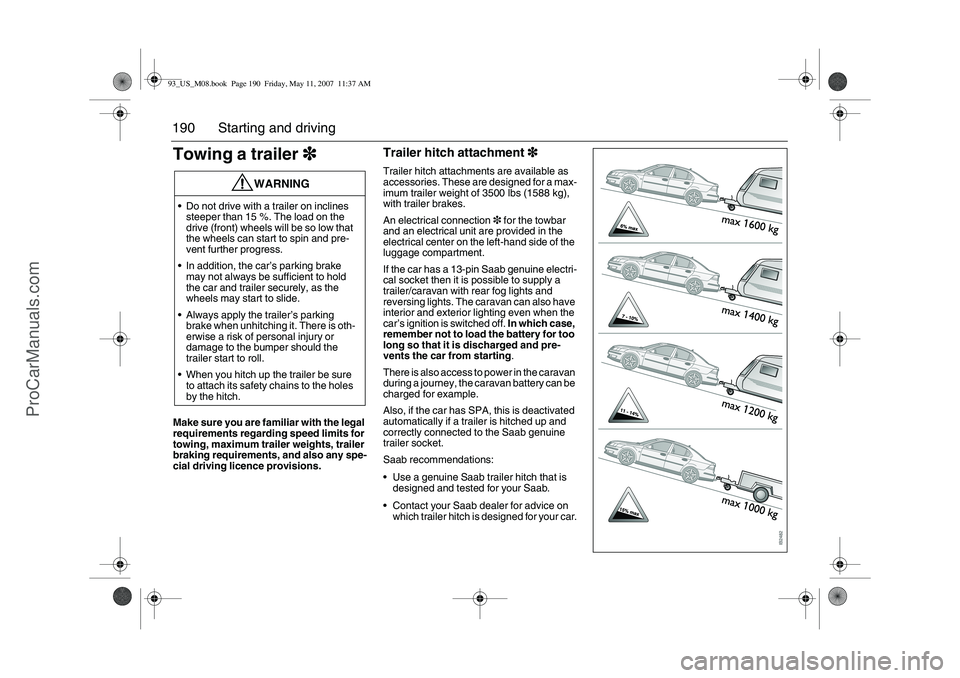
190 Starting and drivingTowing a trailer3
33 3Make sure you are familiar with the legal
requirements regarding speed limits for
towing, maximum trailer weights, trailer
braking requirements, and also any spe-
cial driving licence provisions.
Trailer hitch attachment3
33 3Trailer hitch attachments are available as
accessories. These are designed for a max-
imum trailer weight of 3500 lbs (1588 kg),
with trailer brakes.
An electrical connection3 for the towbar
and an electrical unit are provided in the
electrical center on the left-hand side of the
luggage compartment.
If the car has a 13-pin Saab genuine electri-
cal socket then it is possible to supply a
trailer/caravan with rear fog lights and
reversing lights. The caravan can also have
interior and exterior lighting even when the
car’s ignition is switched off. In which case,
remember not to load the battery for too
long so that it is discharged and pre-
vents the car from starting.
There is also access to power in the caravan
during a journey, the caravan battery can be
charged for example.
Also, if the car has SPA, this is deactivated
automatically if a trailer is hitched up and
correctly connected to the Saab genuine
trailer socket.
Saab recommendations:
Use a genuine Saab trailer hitch that is
designed and tested for your Saab.
Contact your Saab dealer for advice on
which trailer hitch is designed for your car.
WARNING
Do not drive with a trailer on inclines
steeper than 15 %. The load on the
drive (front) wheels will be so low that
the wheels can start to spin and pre-
vent further progress.
In addition, the car’s parking brake
may not always be sufficient to hold
the car and trailer securely, as the
wheels may start to slide.
Always apply the trailer’s parking
brake when unhitching it. There is oth-
erwise a risk of personal injury or
damage to the bumper should the
trailer start to roll.
When you hitch up the trailer be sure
to attach its safety chains to the holes
by the hitch.93_US_M08.book Page 190 Friday, May 11, 2007 11:37 AM
ProCarManuals.com
Page 193 of 320

193 Starting and driving
Checks before drivingMake sure that the car and trailer are in
good working order. This is essential since
towing a trailer increases the strain on the
car.
Check and if necessary adjust the tire
pressure of the car and trailer.
Make sure all wheel bolts are properly
tightened.
Make sure that the equipment joining the
car and trailer is properly secured and
adjusted.
Make sure the trailer’s electrical cable is
properly connected and is not so long that
it drags along the ground. Also, make sure
the cable is not too short and risks break-
ing when turning a corner.
Check all bulbs.
Check the car and trailer brakes.
Make sure that all items on or in the
camper or trailer are properly secured.
Make sure that the trailer’s jockey wheel is
raised and locked.
Check the distribution of the load so that
the car and trailer are well balanced.
Check that the rearview mirrors provide
the best possible rearward vision.
Make sure the trailer’s safety cable is
correctly attached.
Driving considerationsAlways take extra care when towing a
trailer, as the car’s handling will be different
and its braking performance reduced. The
trailer’s braking system and suspension
also have a considerable effect on these
characteristics. See also "Driving with a
load" on page 196.
Drive carefully:
descending hills
on uneven roads
over railway crossings
when meeting large vehicles
If the car has automatic transmission, select
gear M1 when ascending or descending
steep hills.
ReversingGet someone to help you keep an eye out
behind the trailer as the door mirrors do not
always provide sufficient rearward vision
when reversing.
93_US_M08.book Page 193 Friday, May 11, 2007 11:37 AM
ProCarManuals.com